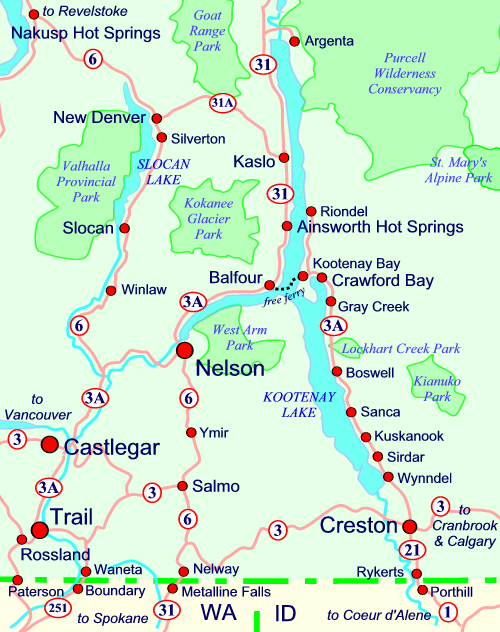
The relatively small city of Nelson (population of 10,000) is found snuggled in the Selkirk Mountains on the west arm of Kootenay Lake in the southern interior of British Columbia in the West Kootenay region.
The East shore of Kootenay lake was once part of the west coast of North America. A collision of the Pacific and North American tectonic plates forced ancient granitic rock to the surface creating the mountains surrounding Nelson and leaving a deep geological fissure that is now the basin of Kootenay Lake. The area was further sculpted by the glaciation that covered two thirds of the North American continent, the erosive force of rivers and streams and the passage of time.
Nelson is 600 meters above sea level and sits upon the South/Eastern boundary of the Interior Cedar Hemlock zone; part of the Coastal Rain Forest System. This amazing ecological system has the most diversity in tree species in British Columbia. Within walking distance of Nelson you will find Birch, Aspen, Cottonwood, Cedar, Hemlock, Lodgepole Pine, Larch, Douglas Fir and many more thriving tree species. Giant old growth Cedar trees can still be found in small pockets throughout the area as can naturally shaped and stunted bonsai spruce and fir in the alpine zones.
The extensive forest lands surrounding Nelson are home to mountain caribou, grizzly and black bears, deer, moose, cougars, skunk (lots of skunk), porcupine and a multitude of other forest dwellers. A quiet hike through the forests is sure to reward you with a glimpse of the animal, bird and insect life that inhabit this area.
Kootenay river which flows down the Kootenay valley to be joined in Castlegar by the Columbia river is a major water way that once supported migrating salmon and continues to be home to freshwater salmon, rainbow, bull and Gerard trout, sturgeon, burbit and many more. The damming of the rivers has altered the geographical terrain of the area, including wild life habitat, and local organizations work with government agencies to restore and maintain the natural environment, ensuring species diversity and survival.
The geographic history of this area continues to be written as human intervention and natural geographic shifts shape the land and contribute to the evolution of the area’s wildlife.
